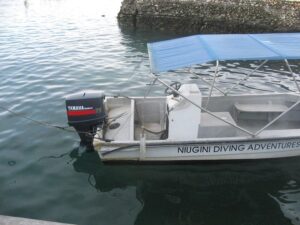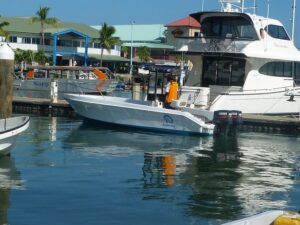Over the summer holiday, I, my son and my nephew were leisurely sitting in my boat, anchored on a glass-calm Jerusalem Bay on Pittwater. I was head down in a newspaper eating a picnic when we heard a small boat creaming and pitter-pattering past with a 2-stroke outboard at full noise – a frenzied, frenetic, full-blooded and urgent buzz. It was magic to the ears – not to mention the heady olfactory treat of 2-stroke exhaust wafting into the air. “That”, I said to the two boys without even looking up, “is a Yamaha 90A.” I was right – and the boys stared at me as if I was some sort of mechanical savant.

For me, there are maybe four epoch-making engines that defined the twentieth century: the original small-block Chevy; the Rolls-Royce/Bentley “six-and-three-quarter” (6.75 litres); the Buick/Rover 3.5 litre alloy V8… and the 1,140 cc Yamaha 85A outboard, which was introduced in 1978. The first three engines had a collective life span of over 130 years before ever-tightening emissions regulations finally euthanised them – but the Yamaha 85A (albeit in several different horsepower designations now) still powers on defiantly and proudly.
I cannot think of any other engine, of any type, that is still being produced in its original form (with no series or model supersession) 46 years after its introduction. And no wonder – it is strong, durable, unburstable and indefatigable. It was the first (extremely successful) attempt by the Japanese at a “large” outboard motor and, as a light, narrow, compact 3-cylinder with loop-charged scavenging, it rendered the thirsty, heavy, crossflow, inline-4 cylinder Mercurys and V4 OMCs of the era obsolete almost overnight. I would, in fact, go so far as to say that the 85A is the motor that lit the slow-burning fuse which eventually put OMC out of business.

Various “new” iterations of the 85A, in different states of tune, can still be bought in developing nations today, with the commercial-use “Enduro” versions earning the sobriquet of the “HiLux of the sea” right across the South Pacific. From a pull-start, hugely detuned 55/60 hp version (which would outlast any boat on which it is mounted), through the ubiquitous Enduro 75, right through to the original-model 85A and the 90A, there are still thousands of them giving sterling, dependable, unfaltering service – all they require is middling-quality petrol and good TCW-3 oil and they will run hour after hour, day after day – laden, unladen, half buried in the water, idling or at wide-open throttle.
Interestingly, I think the Suzuki DT85 (introduced later the same year) was nearly as good in terms of power, reliability and durability, but it never got anywhere near the market share that Yamaha did, and this was due to Yamaha’s determined, focused push into the commercial markets. I would also say that, for my money, the 85A is a veritable icon of design, form and function – up there with a Rolex Datejust, a Swiss Army knife and a Zippo lighter.
Danny Casey is highly experienced, undoubtedly idiosyncratic, and immensely knowledgeable about things mechanical, new or old. His knowledge and passion are as a result of spending his whole life in or around anything power-driven – especially marine engines. His passion for boating is second to none, with his life a montage of fabulous memories from decades spent in or around water and boats, both here and in Europe. Danny has spent myriad years in the recreational marine industry in a varied career in which he has bamboozled colleagues and competitors alike with his well-honed insight.

His mellifluous Irish accent, however, has at times been known to become somewhat less intelligible in occasional attempts at deliberate vagueness or when trying to prevent others from proffering a counter-argument or even getting a word in. Frank and to-the-point, but with a heart of gold, it can be hard to convince Danny to put pen to paper to share his knowledge. Marine Business News is grateful that he took the time to share his thoughts and insight. Connect with Danny through LinkedIn.
To keep up to date with all marine industry news visit www.marinebusinessnews.com.au







